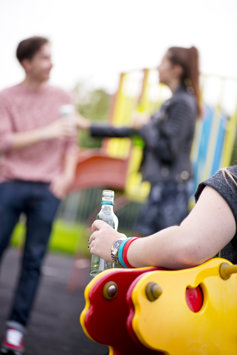
A study of drug and alcohol addiction shows that a significant percentage of alcohol intoxication from oversized alcopops occurs in underage drinkers (46%). This information is alarming, and begs the question of whether oversized alcopops are intentionally made and marketed to underage consumers.
What are oversized alcopops? And should such a product even be on the shelves if almost half of the consumers poisoned by it are not even legally old enough to consume it?
What is alcopop?

An alcopop is an alcoholic beverage that combines the sweet, sugary properties of pop, soda, or sweet tea with alcohol. From the Center for Applied Research Solutions, “’Alcopop’ is a term coined by the popular media to describe bottled alcoholic beverages that are similar to sweet beverages such as soda and lemonade. It is believed that the sweetness of alcopops appeals to younger drinkers more than the taste of wine or beer and may contribute to the general binge drinking among minors. ”The deliberate sweetness and sugary aspect of alcopops are just one of many properties that make it up Make drink more popular with teenagers.
Examples of alcopops are:
- Smirnoff ice cream
- Smirnoff Twisted V
- Bartles & Jaymes
- Mike’s hard lemonade
- Bacardi silver
- Sky blue
- Seagram cool boxes
- Zima
- Jack Daniel’s Country Coolers
- Lynchburg lemonade
- Hard cola
- White Claw
- Spark
An oversized alcopop is simply a sweetened alcoholic beverage that contains a significantly larger amount of alcohol than a normal serving. Some oversized alcopops may contain 5.5 standard alcoholic beverages or more, which means that consuming just one such can of oversized alcopops would constitute excessive alcohol consumption, according to the National Institute on Alcohol Abuse and Alcoholism (more on that later).
Almost half of all alcohol poisoning-related cases of oversized alcopops occur in underage drinkers
A study published in the journal Drug and Alcohol Dependence in May 2021 found a worrying trend. According to the authors: “Between 2010 and 2019 poison control centers received 1,719 calls for exposure to oversized alcopops. Almost half of the calls with excessive alcohol consumption (46.3%) were made to consumers who had not yet reached the legal drinking age. For all years, the proportion of calls for oversized alcopops designed for exposure to minors has exceeded the proportion of calls made for minor exposure to other types of alcohol. ”Oversized alcopops pose a serious risk to people who use them shouldn’t even drink.
“A number of studies that we have conducted have shown that oversized alcopops are commonly consumed by underage drinkers, often with serious negative consequences.”
The study authors are so convinced that oversized alcopops pose a direct threat to underage drinkers that they insisted that something be done to better regulate the products. Dr. Matthew Rossheim quotes: “A number of studies that we have done have shown that oversized alcopops are commonly consumed by underage drinkers, often with serious negative consequences. Our latest data shows a clear trend towards oversized alcopops consumption among underage adolescents in need of poison control services. In this way, oversized alcopops appear to be a definite threat to youth. Better regulation and policies are urgently needed. Limiting alcohol levels and retail availability are immediate steps regulators must take to protect our youth. ”He’s right. To protect young people, alcohol manufacturers need to be held accountable for their products.

A marketing campaign that appeals to young people
It’s hard to deny that alcopop manufacturers create marketing campaigns that excite and interest young people. Alcopops are sweet, fizzy, spicy drinks that are often mixed in such a way that the drinker cannot taste the bitterness of the alcohol. The drinks are very similar to soda, soda, or tea, and the branding and packaging are colorful and cartoonish. As the Alcohol Justice Industry Watchdog wrote, “They (alcopops) are very similar to sodas or energy drinks, and many are up to 12% vol [alcohol by volume]. Alcopops are the transition in the youth (especially girls) industry, from soda to alcohol, fueling alcohol-related harm. ”While this cannot be directly proven, there is reason to believe that alcohol manufacturers are deliberately making oversized alcopops and marketing them to underage consumers .
The Alcohol Justice Industry Watchdog also recorded the history of the oversized alcopops and revealed how the alcohol industry conveniently launched these products immediately after the ban on alcoholic energy drinks. Alcoholic energy drinks were banned mainly because minors drank them and were harmed by it. Again the AJIW quotes: “The first generation of alcopops contained about 5% alcohol by volume. Lately, alcopop producers have increased their alcohol content to 12% or more. Supersized alcopops (the latest version of this product that emerged when alcoholic energy drinks were banned) are packaged and marketed as ready-to-drink alcoholic single-serving beverages. They typically weigh 24 ounces and are high in alcohol (up to 12 vol%), equivalent to 4.7 servings of alcohol. ”Some oversized alcopops contain more than five standard beverages, which is more than any man or woman in one should consume specific day.
The significant risk of binge drinking among minors

Underage drinking is harmful, and underage binge drinking is worse. According to the Alcohol Justice Industry Watchdog, “Alcopops are fueling the alcohol consumption epidemic among minors. Since they don’t taste, smell, or look like alcohol, alcopops serve as a transition or bridge from soft drinks to alcohol, especially for young girls. Underage girls drink alcopops more than any other type of alcoholic beverage. While the industry says these drinks are intended for adults, women 21 and older rank alcopops as the least consumed alcoholic drink. About a third of teenage girls between the ages of 12 and 18 and a fifth of teenage boys have tried alcopops. ”Of all the different types of alcoholic beverages, alcopops appear to be the most likely to be consumed by underage boys and girls, which questions whether Alcohol manufacturers may or may not make them.
According to the National Institute on Alcohol Abuse and Alcoholism, approximately 25% of Americans over the age of 18 drink each month. Around 4.2 million young people between the ages of 12 and 20 drink each month. This figure corresponds to at least 11% of the population in this young age group.
The NIAAA defines binge drinking as “a drinking pattern that brings BAC levels to 0.08 g / dL or higher. This usually happens after a woman has had 4 drinks or a man has had 5 drinks – in about 2 hours. ”When oversized alcopops contain more than 4 or 5 standard drinks at a time one it becomes clear that consuming just one oversized alcopop is binge drinking.
There is no doubt that alcohol consumption, especially binge drinking, is extremely harmful to young people. Research has shown that teenage alcohol consumption can interfere with normal brain development in adolescents and increase the risk of the person developing alcohol addiction. Alcohol use by minors also has acute harmful consequences such as injuries, car accidents, sexual assault, alcohol overdoses and deaths.
Thousands of people under the age of 21 die each year from alcohol-related causes, including over 1,000 deaths from car accidents, approximately 1,000 homicides, 208 alcohol overdoses, falls, burns and drowning, and nearly 600 alcohol-related suicides.
Given the serious harm alcohol consumption is doing to young people, it would be advisable to make dedicated efforts to discourage young adults and adolescents from consuming oversized alcopops.
Preventing alcohol abuse and treating alcohol addiction in young people
Families (especially parents), educators, public health officials, policy makers and consumers must all demand that alcohol companies stop making products that pose a particular risk to young people. In addition, young people need to be adequately educated about the risks and dangers of alcohol. When teens know the truth about how alcohol can harm their lives and negatively affect their future, they will experiment less.
Finally, if a young person starts abusing alcohol and cannot stop, they must seek help from an inpatient drug and alcohol addiction treatment center as soon as possible.






